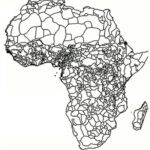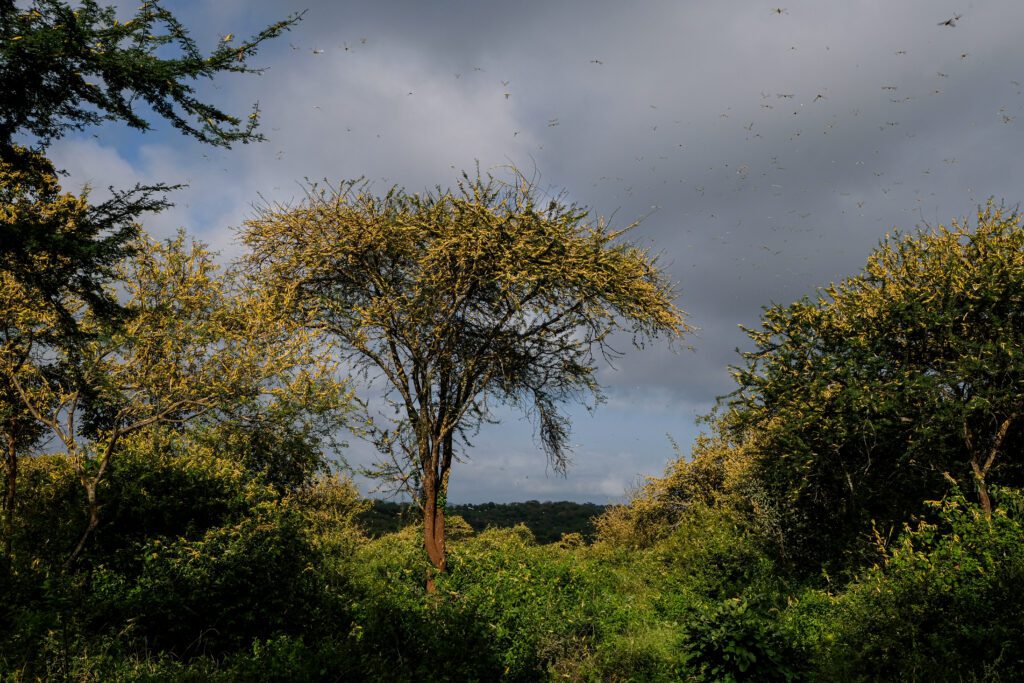Photography by Joost Bastmeijer
When dawn is still in the distance, the desert locusts hang lethargically in the trees. From a distance it seems as if the trees are covered with a dense layer of yellow flowers. With the first warmth of the sun the feelers of the cold-blooded animals start moving and after an hour they stretch their wings. And then -suddenly- one of them startles, the bunches explode and send thousands and then millions into the air. The sky is strewn, the light is dim. The desert locusts take over the world at Kamuwongo in northeast Kenya.
Their success story began at the end of 2018, when two large cyclones above the Indian Ocean brought heavy rain to the Saudi Arabian desert. The warm humidity in the region created an ideal situation for reproduction and swarms went east to Iran and as far as India. In Yemen the war made combat near impossible. And so, they expanded to Africa, from Djibouti to Eritrea and lawless Somalia, to Ethiopia and Kenya.
It has been raining extensively in East Africa since the small rainy season that started in October. Rains have fallen many times more than usual. All vermin seize their chance. White butterflies flutter among desert locusts, numerous malaria mosquitoes in the evenings search for blood and army worms may be preparing for their march of destruction. Yet the rains also brought prosperity. A more than normal harvest is expected in the region and most crops such as corn and sorghum were already ready to harvest. So, for now, the damage remains limited in this region.
The spraying on the ground and from the air appears to have been inadequate since the invasion last month. The first two pesticides used did not work well. The locusts were only stunned, started eating less but did not die.
The locust fighters of the ministry keep each other informed with a WhatsApp group. The desert locust is a nomad and rarely sleeps in the same place. Where they were yesterday, they have disappeared today. A message appears about another swarm, fifty kilometres away in the picturesque landscape with red earth, balding rock mountains and baobab trees. Simon Kange, a local employee of the ministry, rode in the morning on his motorbike in the area of Kyuso and got covered with the locusts.
In the afternoon he takes me there again. Upon arrival with Simon the swarms go back and forth in the air, in wave movements from left to right, and higher up in the sky too, and above that another layer. Not millions but billions, maybe even more. Their shadows dot on the floor, like a reflection of a crystal ball. A layer of small shit covers the earth. Farmer Bernard Mulala comes running towards us. He can’t shake our hands, because his arms wave continuously. Since morning he has been waving. And keeps waving. He is in shock; he cannot stop even though he has already given up the fight. “I cannot continue”, he says in a hoarse screamed voice, “it drives me crazy.”
“Go away, go away, you vermin,” two young farmers shout in a field on the other side of the sandy track. A man on a moped gets off, because his view gets obstructed, a shepherd boy passes by, his cows hardly visible. A young girl waves her way through the pests with her school uniform’s sweater.
“The females lay more than fifty eggs each,” says Simon. They dig holes in the loose sand. “I saw them this morning in an area covering 25 square kilometres. This is where the disaster begins. In three weeks, that one female will have multiplied at least fifty times”. At sunset the desert locusts roost again, so that they can continue their advance tomorrow.
This article was first published in NRC Handelsblad on 11-2-2020

